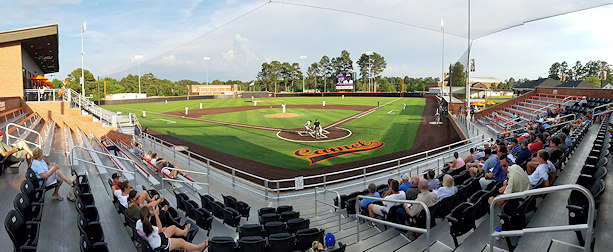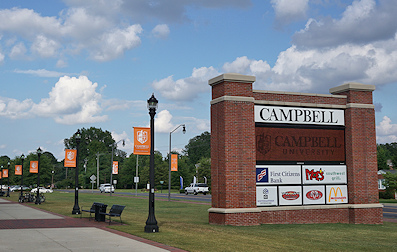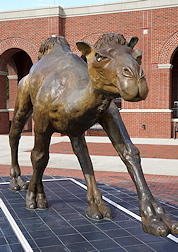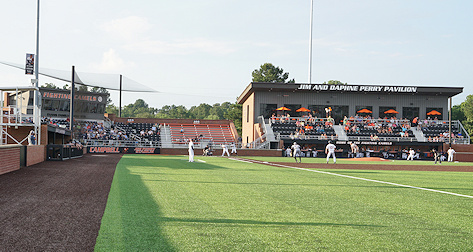Article and all photos by Joe Mock, BaseballParks.com
All rights reserved
Minor League Baseball had a problem. The Rangers and the Astros didn’t want their High-A affiliates on the West Coast, yet they were stuck in High Desert and Lancaster of the Cal League. Further, two of the ballparks in that league were far from meeting Minor League standards, and the parent teams of the clubs playing there were decidedly unhappy.
Since there can be no more and no less than 30 High-A teams, and each of the three High-A leagues has a very defined geographic area, the quantity of teams in each league determines the number of franchises in various parts of the country. Consequently, Minor League Baseball made a bold move to address the two poor facilities in California and the desires of two MLB teams to be in the East: reduce the number of Cal League teams from ten to eight and increase the Carolina League from eight to ten. The Florida State League is the other circuit at this level, and it remains at 12 teams.
This maneuver is far more involved than it sounds, because the franchises had owners. In the end, though, the two new additions in the Carolina League are owned by their Major League parents. Therefore, the Buies Creek Astros are owned by, of course, the Houston Astros and the Down East Wood Ducks are owned by the Rangers. The latter is located in Kinston, NC – where the Rangers have been trying to place their High-A affiliate for several years now.
The ballpark arrangements of these two new teams couldn’t be more different. Buies Creek’s park is very modern, with artificial turf. It’s new in the Carolina League, but it’s only a temporary home for the Astros. And it’s on a college campus. Kinston’s stadium is decidedly old school, and had served as a Carolina League venue in the past. That’s real grass the young Rangers are on, and the franchise is going to be there – in an old neighborhood – a long, long time.
Now let’s look at the home of the Buies Creek Astros. Tomorrow we’ll post our thoughts on Grainger Stadium in Kinston.
JIM PERRY STADIUM IN BUIES CREEK, NC

The Astros and Rangers have approached their moves to North Carolina in markedly different ways. While the Rangers had been angling to get to Kinston for years (first hoping that Binghamton’s Eastern League team would move to Wilmington, Delaware so the Carolina League team there could move to Kinston), it appeared the Astros were wanting to move from California to the Carolinas without a clear picture of where the franchise would land.
| Ballpark Stats |
 |
| Team: Buies Creek Astros of the Carolina League |
| First pro game: April 6, 2017, a 5-3 win over Winston-Salem |
| Capacity: 1,000, including 630 permanent seats |
| Dimensions: LF – 337; LCF – 368; CF – 395; RCF – 375; RF – 328 |
| Home dugout: 3B side |
| Field points: Southeast |
| Playing surface: Pro Grass Turf (artificial) |
| Ticket info: buiescreekastros.com |
| Betcha didn’t know: The population of Buies Creek is 2,942. |
So the leaders of the MLB team surveyed the landscape, and decided that none of the existing ballparks in North or South Carolina would do. They wanted a brand-new facility, and were willing to park their High-A team in a temporary home until one could be built.
The execs in Houston decided that Fayetteville, NC would make a nice permanent home. The city just had to be persuaded to build the team a new stadium. In other words, the Astros courted Fayetteville, rather than the other way around. As one local member of the media (who has worked in other Minor League markets) told me, “I’ve never seen anything like it.”
Fayetteville had once been the home of affiliated Minor League Baseball, but the Cape Fear Crocs of the South Atlantic League had bolted to a brand-new park in Lakewood, New Jersey in 2001. The park they left behind (J.P. Riddle Stadium) no longer fit the bill for pro ball, and is currently enjoying a very successful run as the home of the Swamp Dogs, a summer-wood-bat team for college players. One also surmises that if the Astros had agreed to move to Riddle temporarily, they might’ve lost some leverage to get Fayetteville to hurry up and build a new park.
So as the Astros were working with (or perhaps working on) Fayetteville on a new park, they found a temporary home on the campus of Campbell University in tiny Buies Creek, a half hour north of Fayetteville. There the Fighting Camels (yes, that’s really the school’s nickname) of the Big South Conference had developed a solid baseball program, and in 2013 had unveiled a rebuilt ballpark with excellent facilities.
The rebuilt stadium is named for Jim Perry, the 1970 AL Cy Young winner, who made a donation to help pay for the renovations. He also happens to have attended Campbell from 1956 through ’59.
  |
| Since the ballpark is in the middle of Campbell’s campus, you pass by the entrance to the University as well as the Fighting Camel statue. |
The Astros maintain only a two-person front office (that operates just a few blocks from where the new park will be built in Fayetteville, not in Buies Creek) for the team. But it’s the baseball staff of the University that handles the gameday operations of the pro games.
And they do it surprisingly well. To be sure, it’s a minimalist presentation, with no screaming “host” leading silly between-innings relay races and make-your-face-look-like-the-emoji challenges. Instead, the PA announcer does a tasteful job of informing fans of who’s at bat, and between innings the music plays without all of the other drama and distractions. As a local writer told me, “It’s baseball in its purest form.”
I found that I enjoyed it immensely.
“The staff here at Campbell has been beyond gracious to us,” Scott Fults, Director of Ballpark Operations (and one of the two employees of the team), told me. “You can tell Campbell is very invested in the success of our team.”
 There’s no radio play by play, but there’s a concession stand serving $3 hot dogs and $2 sodas (you can’t beat that at a pro game) and a trailer featuring $20 t-shirts and caps. And the high-resolution video screen in right field is a beauty – donated by the Carli C’s grocery chain, a long-time supporter of Fighting Camel athletics. There are few nicer at this level of the Minors — much less in college.
There’s no radio play by play, but there’s a concession stand serving $3 hot dogs and $2 sodas (you can’t beat that at a pro game) and a trailer featuring $20 t-shirts and caps. And the high-resolution video screen in right field is a beauty – donated by the Carli C’s grocery chain, a long-time supporter of Fighting Camel athletics. There are few nicer at this level of the Minors — much less in college.
The playing surface is both exceptional and new. The artificial surface is made by Pro Grass, and the Astros paid to have it installed prior to the 2017 season. Only the mound is made of dirt. Everywhere else is synthetic, which we’re seeing more and more in college baseball.
The ballpark’s capacity is exceedingly small for High-A baseball, but it’s big enough for the fans who pay the incredibly low price of $7 for a reserved seat. And most importantly, the Astros aren’t the least bit bothered by the paltry attendance compared to the other teams in the league. They’re happy their prospects are playing in a first-class facility while the new stadium 30 miles to the south is taking shape.
There are only 630 permanent seats in the park, and they claim that 1,000 fans can fit within its confines. The nicest seating sections are behind the home dugout on the third-base side, where there’s also an air-conditioned lounge behind a patio for group events.
While I’m sure the Buies Creek Astros would love for ticket-buyers at Jim Perry Stadium to one day be season-ticket holders in Fayetteville, there doesn’t appear to be a high-pressure sales effort at the games. In fact, if you want to express interest in tickets at the new park, you can go by the team’s office in Fayetteville and write your name on a clipboard.
It’s all very quaint – and a wonderfully refreshing approach to running a pro-baseball franchise.
Tomorrow, we’ll post the results of our visit to the Down East Wood Ducks.
